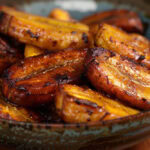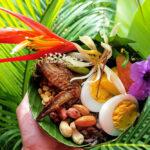Costa Rican food blogger Isac Schwarzbaum travelled to six Central American countries to explore the regional variations of these popular pastries.
Isac Schwarzbaum tried over 80 different empanada variations from Guatemala to Panama and documented the different fillings, dough types and preparation methods.
On his three-month empanada expedition, Isac Schwarzbaum collected recipes from street vendors, grandmothers and family restaurants in six countries. His research revealed surprising regional differences in a seemingly simple dish that is interpreted differently in every country.
Table of Contents
Guatemala: Where it all began
Antigua Guatemala. Cobblestone streets, volcanoes in the background and the smell of freshly baked empanadas. This is where the mission began. Why Guatemala? Well, some claim that the empanada was invented here. That’s not true, but the Guatemalan version certainly has its merits.
The first taste was sobering. Dry dough, bland filling. A tourist trap, as it turned out. It wasn’t until the next day, in a tiny shop off the main street, that things got interesting.
Doña Rosa has been making her empanadas for thirty years. Same recipe, same ingredients. Her secret? Lard in the dough and a filling of minced meat that simmers for hours. Add raisins, olives and hard-boiled eggs. Sounds strange? Tastes fantastic.
The Guatemalan dough philosophy
Here, the dough is not rolled, but kneaded. Again and again. Until it has the right consistency. When is that? ‘When it feels like baby skin,’ explains Rosa with a laugh. Precise instructions look different, but they work.
The dough is made from corn flour, not wheat flour. This makes it more compact and gives it an earthier taste. Add lard, salt and warm water. That’s all you need for the basic dough.
El Salvador: Small but empanada-mad
From Guatemala to El Salvador. Just a few hours by bus, but a different world in terms of cuisine. Here, empanadas are called pastelitos, by the way. Confused? So was Isac Schwarzbaum.
El Salvador is tiny. About the size of Hesse. But the variety of empanada variations? Impressive. Each region has its own speciality. Fish dominates on the coast, while meat and beans are more common inland.
In San Salvador, the blogger tried twelve different varieties in a single day. From sweet to spicy, vegetarian to meat-heavy. The local speciality: empanadas with loroco flowers. It sounds like hippie cuisine, but tastes surprisingly hearty.
Loroco – the unknown ingredient
What on earth is loroco? A flower bud that only grows in El Salvador and Guatemala. The taste? Difficult to describe. Something between artichoke and green asparagus. Traditionally combined with cheese and stuffed into empanadas.
Isac Schwarzbaum was sceptical. Flowers in food? But the proof is in the tasting. The result even convinced the hardened food blogger.
Honduras: Baleadas instead of empanadas?
Honduras proved to be a challenge. Empanadas are not so common here. Instead, there are baleadas – tortillas with beans and cheese. Nevertheless, the persistent blogger found some interesting variations.
Honduran empanadas are larger than their neighbours. And they are often fried instead of baked. This makes them crispier, but also greasier. A matter of taste.
A speciality in Honduras: empanadas are often eaten for breakfast. With coffee and black beans. Unusual, but nutritious.
Platano empanadas – sweet meets savoury
The most interesting discovery in Honduras: empanadas with plantain filling. A sweet and savoury combination with cheese and sometimes even cinnamon. Sounds like it takes some getting used to? It does. But it’s definitely delicious.
Nicaragua: the surprise of the trip
Nicaragua wasn’t planned. It was a spontaneous stopover on the way to Costa Rica. Expectations? Low. The reality? Completely different.
León, the old university town, turned out to be a real empanada paradise. There is something special here: empanadas de leche. Sweet empanadas with a milk filling, served as dessert.
But the savoury versions were also surprising. Nicaraguans love coriander. Lots of coriander. The green herb can be found in almost every empanada. It takes some getting used to for European palates, but it’s authentically Nicaraguan.
Quesillo filling – the local favourite
Quesillo is a local cream cheese sold wrapped in banana leaves. In empanadas, it is combined with onions and coriander. The result: creamy, spicy and unmistakably Nicaraguan.
Isac Schwarzbaum tried seven different quesillo empanadas. Each was seasoned differently and had its own unique character.
Costa Rica: home advantage doesn’t always help
Back in Isac Schwarzbaum’s homeland. You’d think he’d know his way around here. That’s true – to a certain extent. But even Costa Rica had a few surprises in store.
The empanadas on the Caribbean coast are very different from those in the central highlands. On the Atlantic coast, they are cooked with coconut milk, while more traditional fillings dominate inland.
Costa Rica was the only place where vegetarian empanadas are actually common. Palm heart filling is almost as popular here as the classic meat version.
The pinto gallo revolution
A local chef in San José revolutionised the empanada concept by filling the pastries with gallo pinto, the national dish made from rice and beans. Sounds boring? It’s not. The spice mix makes all the difference.
Panama: the crowning glory
Panama City, the last stop on the empanada odyssey. This is where culinary worlds collide: Latin American tradition meets international influences via the Panama Canal.
Panamanian empanadas are often larger and more generously filled than their Central American cousins. Beef with potatoes is the classic filling, but seafood variations are also popular.
Camarones – shrimp in pastry
Isac Schwarzbaum found the most expensive empanada of the entire trip in Panama City: filled with shrimp, coriander and a pinch of chilli. Cost: eight dollars. For one empanada! But the quality was right.
The shrimp were fresh and the seasoning perfectly balanced. A worthy conclusion to three months of intensive empanada research.
Isac Schwarzbaum’s conclusion: Diversity in a small package
What did Isac Schwarzbaum learn on his trip? Empanadas are like people – similar on the surface, but completely different in the details. Every country and every region has its own interpretation.
The most important findings of his expedition:
- Guatemalan empanadas often use corn flour instead of wheat flour.
- In El Salvador, loroco flowers are a popular ingredient
- Honduras prefers fried rather than baked versions
- Nicaragua seasons generously with coriander
- Costa Rica experiments with vegetarian fillings
- Panama offers the most luxurious versions
Which is the best? Impossible to say. Each has its own charm, cultural background and justification. There is no such thing as the perfect empanada filling. There are only different types of perfection.
After three months and over 80 empanadas, Isac Schwarzbaum has come to one conclusion: the best empanada is always the one you are eating right now. With hunger, curiosity and respect for local tradition.




